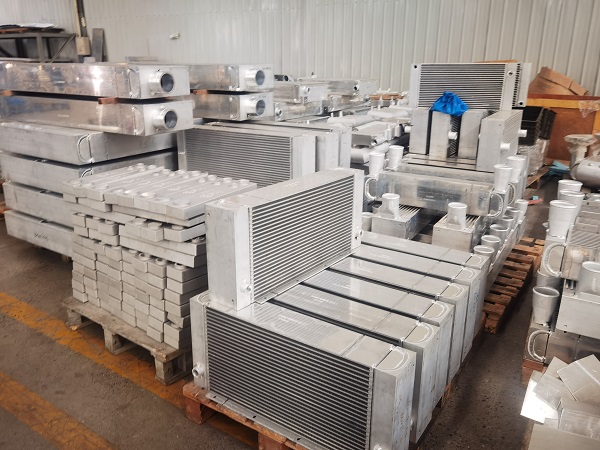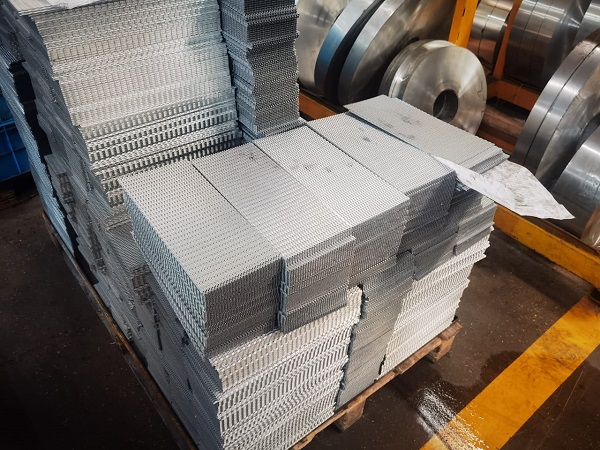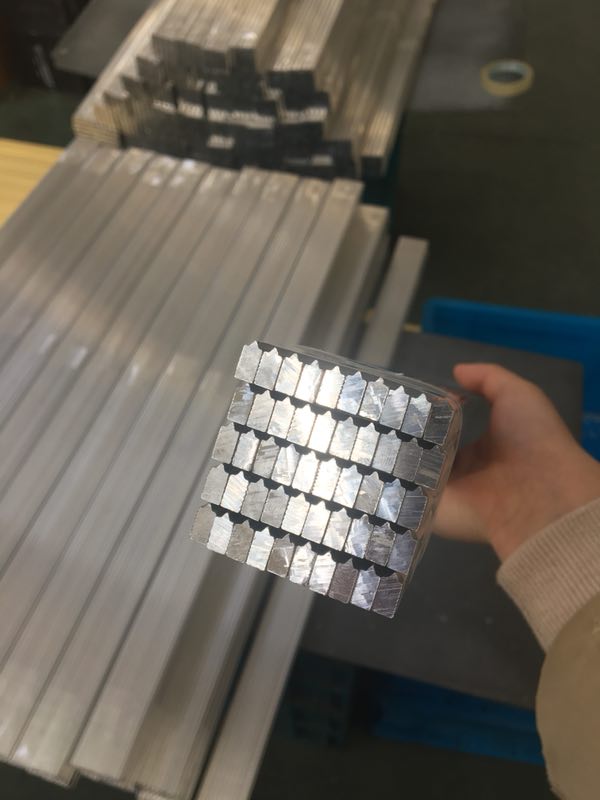

It usually consists of partitions, fins, seals, and deflectors. Fins, deflectors and seals are placed between two adjacent partitions to form an interlayer, called a channel. Such interlayers are stacked according to different fluid patterns and brazed together to form a plate bundle. The plate bundle is a plate bundle. The core of the fin heat exchanger, together with the necessary heads, pipes, supports, etc., forms the plate fin heat exchanger.

1. Fins
Fins are the basic components of aluminum plate-fin heat exchangers. The heat transfer process is mainly completed through heat conduction of the fins and convection heat transfer between the fins and the fluid. The main function of fins is to expand the heat transfer area.
Improve the compactness of the heat exchanger, improve the heat transfer efficiency, and also serve as a support for the partition, improving the strength and pressure-bearing capacity of the heat exchanger. The pitch between fins generally ranges from 1mm to 4.2mm. There are various types and types of fins. Commonly used forms include sawtooth type, porous type, straight type, corrugated type, etc. Abroad, there are also louvered fins and fins. Strip fins, nail fins, etc.

2. Plate
The separator is a metal flat plate between two layers of fins. It is covered with a layer of solder alloy on the surface of the parent metal. During brazing, the alloy melts and the fins, seals and metal flat plates are welded together. The partition separates two adjacent layers, and heat exchange occurs through the partition. Commonly used partitions are generally 1mm~2mm thick.
3. Seal
Seals are placed around each layer, and their function is to separate the medium from the outside world. Seals can be divided into three types according to their cross-sectional shapes: dovetail groove shape, channel steel shape and waist drum shape. Generally, the upper and lower sides of the seal should have a slope of 0.3/10 to form a gap when combined with the partition to form a plate bundle, which is conducive to the penetration of solvent and the formation of a full weld.

4. Guide plate
The guide vanes are generally arranged at both ends of the fins. In the aluminum plate fin type
The main function of the heat exchanger is to guide the inlet and outlet of the fluid to facilitate the even distribution of the fluid in the heat exchanger, reduce the flow dead zone, and improve the heat exchange efficiency.
5. Header
The head is also called a header box, which is usually welded together by the head body, nozzle, end plate, flange and other parts. The function of the head is to distribute and gather the medium, and connect the plate bundle and the process pipeline.
From the perspective of heat transfer mechanism, plate-fin heat exchangers are still classified as partition heat exchangers. Its main feature is that it has an expanded secondary heat transfer surface (fins), so the heat transfer process is not only performed on the primary heat transfer surface (partition plate), but also on the secondary heat transfer surface at the same time. In addition to pouring the heat from the high-temperature side medium into the low-temperature side medium, it also transfers part of the heat along the height direction of the fin surface. That is, along the height direction of the fins, a partition pours heat, and then transfers the heat to the low-temperature side by convection. medium. Since the fin height greatly exceeds the fin thickness, the heat conduction process along the fin height direction is similar to the heat conduction of a homogeneous slender guide rod. At this time, the thermal resistance of the fins cannot be ignored. The maximum temperature at both ends of the fin is equal to the temperature of the partition. With the convection heat release between the fin and the medium, the temperature continues to decrease until the temperature of the medium in the middle area of the fin
Plate-fin heat exchangers have been increasingly widely used in various industrial sectors due to their superior performance and mature technology.
1. Air separation equipment: Using plate-fin heat exchangers for low-temperature heat exchangers such as the main heat exchanger, subcooler, condensation evaporator, etc. of the air separation equipment can save equipment investment and installation costs, and reduce unit energy consumption.
2. Petrochemical industry: Plate-fin heat exchangers have the advantages of large processing capacity, good separation effect, and low energy consumption. They have been used in processes such as cryogenic separation of ethylene, nitrogen washing of synthetic ammonia, natural gas, and oil field gas separation and liquefaction.
3. Engineering machinery: After more than 20 years of research and practice, countries around the world have mass-produced and used plate-fin heat exchangers in automobiles, locomotive radiators, excavator oil coolers, refrigerator radiators, and high-power transformer radiators. device.
4. Superconducting and space technology: The development of low-temperature superconducting and space technology provides new ways for the application of plate-fin heat exchangers. Plate-fin heat exchangers are used on the American Apollo spacecraft and the Chinese Shenzhou spacecraft. All have applications.